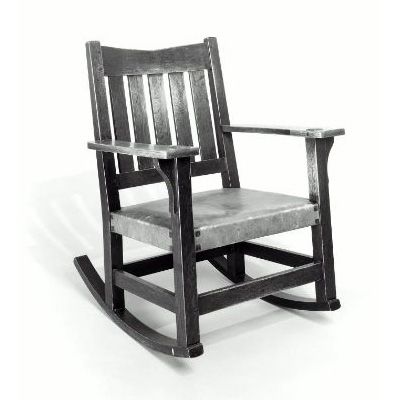
Synopsis: An article written before Stickley’s resurgence in popularity, this piece offers thorough detailing of the history and growth of the Gustav Stickley style. Stickley was determined to create a persona and streamlined construction that would eliminate most needless decoration. Each article was to be free from pretense, and in his own words, “fitted for the place it was to occupy and the work it had to do.” Learn about Stickley’s aesthetic goals, motto, materials, and successes; the eager throngs who copied him for their own profit; and how his company weathered the competition.
One of the last great designer-craftsmen to come out of the 19th century was Gustav Stickley. Today, this cabinetmaker and entrepreneur is almost forgotten. But for 15 brief years before World War I, Stickley’s “Craftsman” furniture and furnishings enjoyed great popularity. A change in popular taste and the onslaught of mass-produced goods spelled the end of his success. Now, however, Stickley’s work is being rediscovered in attics, barns and secondhand thrift shops and appearing on the more prestigious (and expensive) antiques circuit.
Born in 1857 in Wisconsin, Stickley was trained by his father as a stonemason, but soon left to learn cabinetmaking from an uncle in Pennsylvania. After working in furniture factories and stores, he formed a distaste for the gaudy pieces generally popular at the time and developed instead an admiration for the simple and sturdy forms of the Shaker furniture he had seen.
Stickley was also influenced by the decorative arts coming out of Chicago in the 1870’s, one of the pulse centers of the arts and crafts movement in this country. A trip abroad to see “art nouveau” and English arts and crafts designs convinced him further to purify furniture forms. He became determined to create a personal, streamlined construction that would eliminate most needless decoration, with each article free from pretense, and in his own words, “fitted for the place it was to occupy and the work it had to do.” He thus, for the most part, avoided the “tortured and fantastic lines” based on the organic plant forms of which the art nouveau enthusiasts were so fond, preferring to omit “intrusive” inlay, artificial “affectation,” and those forms that evoked the past in a “quaint” or historical way.
In his quest to develop a distinctive style, he took the medieval joiner’s compass as his symbol and borrowed the motto “Als ik Kan” (“As I can,” or, more broadly, “All I can”) from Jan van Eyck because it was “brief, modest and not always easy to fulfill.”
From Fine Woodworking #2
For the full article, download the PDF below:
Fine Woodworking Recommended Products

Blackwing Pencils

Compass

Dividers





















Log in or create an account to post a comment.
Sign up Log in